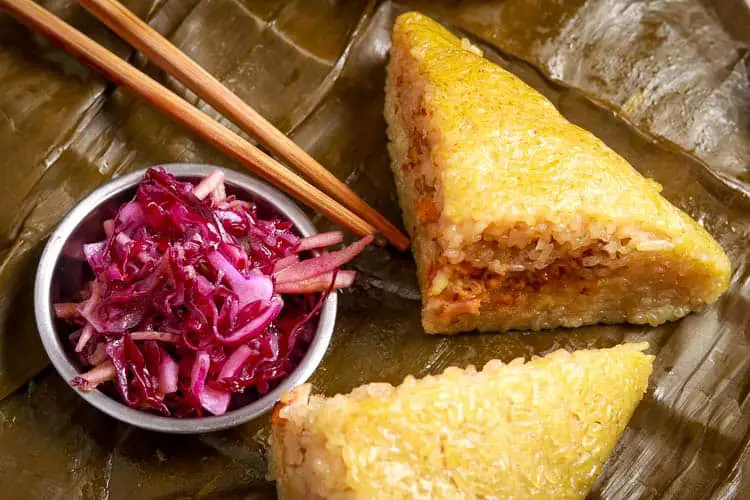Bochin Vietnamese rice cakes are a delightful, traditional snack that have been enjoyed in Vietnam for generations.
If you’ve ever wondered what makes these rice cakes so special, you’re in the right place.
They’re not your average rice cake – these are packed with flavor, history, and a unique texture that sets them apart from the ones you might find at your local grocery store.
bochin vietnamese rice cakes are made from glutinous rice, which gives them that chewy, sticky texture. They’re often wrapped in banana leaves, adding an earthy aroma and a little extra flavor.
These rice cakes come in various forms, but they all share one thing in common: they’re delicious.
The Story Behind bochin vietnamese rice cakes
bochin vietnamese rice cakes are deeply rooted in Vietnamese culture.
They’ve been a part of the Vietnamese culinary tradition for centuries, especially during the Lunar New Year celebrations, or Tết.
For many Vietnamese families, making bochin rice cakes is a time-honored tradition passed down through generations. It’s more than just about the food; it’s about family, togetherness, and honoring the past.
In Vietnam, the process of making bochin vietnamese rice cakes is an event in itself, often involving entire families gathering to prepare and cook them. The cakes are sometimes filled with savory ingredients like pork, mung beans, or even sweet fillings like coconut.

What Makes Bochin Vietnamese Rice Cakes Unique?
So, what exactly sets bochin vietnamese rice cakes apart from other rice cakes?
- Texture: The glutinous rice gives these cakes a chewy, sticky texture that’s unlike any other rice cake you’ve probably tried. It’s satisfying to bite into and holds its shape well.
- Banana Leaf Wrapping: Wrapped in banana leaves, bochin rice cakes have a subtle, earthy flavor that complements the rice perfectly. The leaves also help keep the cakes moist and tender.
- Variety: Bochin rice cakes come in various forms and flavors. From savory to sweet, there’s a bochin rice cake for everyone.
- Cultural Significance: These rice cakes aren’t just food – they’re a part of Vietnamese heritage. They symbolize prosperity, good fortune, and unity.
How Are Bochin Vietnamese Rice Cakes Made?
Making bochin vietnamese rice cakes is an art form in Vietnam.
It’s not something you can just whip up in a few minutes.
The process involves soaking glutinous rice overnight, preparing the fillings, and carefully wrapping each cake in banana leaves. Then, they’re steamed for hours, which gives them their distinctive texture and flavor.
Here’s a quick breakdown of how bochin vietnamese rice cakes are made:
- Soak the Rice: Glutinous rice is soaked overnight to soften it up.
- Prepare the Fillings: Depending on the type of bochin rice cake, the filling can include savory ingredients like pork or mung beans, or sweet ones like coconut.
- Wrap the Cakes: The rice and fillings are carefully wrapped in banana leaves to hold everything together.
- Steam: The wrapped cakes are steamed for several hours until they’re fully cooked and tender.
It’s a labor-intensive process, but the end result is worth it.
Where to Find Bochin Vietnamese Rice Cakes
If you’re not in Vietnam and want to try bochin rice cakes, don’t worry. You can find them in Vietnamese markets or specialty stores, especially during the Lunar New Year season.
Many Vietnamese restaurants also offer them as part of their menu, so it’s worth asking if they serve bochin rice cakes.
If you’re feeling adventurous, you could even try making them at home. There are plenty of recipes available online, and with a little patience, you can recreate this Vietnamese delicacy in your own kitchen.
Frequently Asked Questions About Bochin Vietnamese Rice Cakes
Are bochin vietnamese rice cakes Gluten-Free?
Yes! Since bochin vietnamese rice cakes are made from glutinous rice, they are naturally gluten-free. Just make sure that any fillings you add are also gluten-free.
Can I Make bochin vietnamese rice cakes in Advance?
Absolutely. Bochin rice cakes can be made ahead of time and stored in the fridge for a few days. You can even freeze them for longer storage. Just steam them again before serving to bring back their softness.

What Are Some Common Fillings for Bochin Rice Cakes?
bochin vietnamese rice cakes come in both savory and sweet varieties. Common savory fillings include pork, mung beans, and salted egg. For a sweet version, you might find fillings like coconut, sugar, and sometimes even lotus seeds.
Are bochin vietnamese rice cakes Healthy?
bochin vietnamese rice cakes can be a healthy snack, especially if they’re filled with vegetables and lean meats. However, the glutinous rice does make them a bit more calorie-dense compared to regular rice cakes. As with any food, moderation is key.
Why You Should Try Bochin Vietnamese Rice Cakes
If you’ve never had bochin Vietnamese rice cakes, you’re missing out on a true taste of Vietnamese culture.
These rice cakes are not just food – they’re a connection to the past, a celebration of family, and a testament to the rich culinary heritage of Vietnam.
The chewy texture, the earthy banana leaf wrapping, and the delicious fillings make bochin rice cakes a must-try for anyone who loves trying new foods.
So, whether you’re visiting Vietnam or simply looking to experience something new, bochin Vietnamese rice cakes should be at the top of your list.
And remember, these rice cakes are more than just a treat – they’re a piece of history, a symbol of togetherness, and a delicious reminder of the simple joys in life.